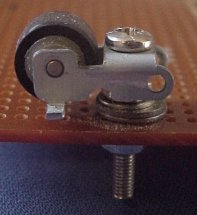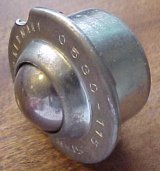Geometry? Well I couldn’t think of another single word that described the arrangement of the wheels and so on.
Basically you have a few choices when you come to decide things like how many driving wheels to have. Is more better? Will you be steering with the driving wheels? How are you going to go round corners and what do you do on an uneven surface.
To tackle the last point first you should note that any arrangement that has three wheels or points of contact will always have all of them on the ground at the same time. Assuming you don’t have a high centre of gravity and fast turns that is.
The section on steering has some stuff to say about the arrangement of wheels for steering so lets think about a few other factors.
For stability, your wheels want to be a long way apart. Too far apart and they will make it difficult for you to navigate corners. If you ever want to travel along diagonals in the maze, the total track must not be more than about 110mm.
Big wheels make light work of irregularities in the maze floor. You don’t have to turn them so fast to get a good turn of speed but small rotations of the wheels will correspond to relatively large distances on the ground. If you have shaft encoders on the driving wheels, can you get enough resolution out of them if those driving wheels are big? Don’t gear up your distance sensors or slop in the gear train could finish you off.
What will happen when you hit a bump. As already pointed out, you could end up with the driving wheels suspended in the air. I have seen that happen, not funny really. Having four, driven wheels means that you can always drive out of trouble like that. If you have only three points of contact, you cannot suffer that problem. Small wheels or castors will have more trouble going over bumps. With some of the mouse weight resting on a castor, can your mouse push/drag it over any reasonable bump? Can it do so without losing track of where it is?
For a wheelchair mouse you might have a castor or some such front and back or just at one end. If the castor is only at one end, you must be sure that some of the weight of the mouse always rests on it. The more weight that rests on the castor, the more stable the mouse will be. There will also be less weight on the driving wheels and so less acceleration or a greater tendency for wheelspin.
As you accelerate, the weight distribution on the wheels will change due to reaction torque in the mouse body. Four wheel mice do better here. A wheelchair mouse with a rear castor will suffer a reduction in weight on the driving wheels as it accelerates. On the other hand, weight will be transferred forwards under braking. Either way, you don’t really want to lose contact with the floor or you run the risk of tipping over. With only three points of contact, your mouse may tip alarmingly under heavy acceleration or braking.
As you accelerate and brake, there is the chance that your wall sensors will move up and down. Can you reliably detect the walls when this happens? Sprung suspension and a forward castor will eliminate this but is mechanically more complex.
Put the castor as far as you can from the driving wheels to minimise many of these effects. If you have a front and rear castor then spring one and/or ensure that you can’t beach yourself on steps. The rules say steps should be no more than 0.5mm but take no chances.
 |
What are you going to use for a castor. An actual castor wheel is a bit of a nuisance. Firstly, it needs room – both height for the wheel and space for the thing to rotate. It will need to rotate freely through a full 360 degrees. As they rotate, they change the distance from the drive wheels and thus the height of the wall sensors. Unless well made and mounted, they present lateral forces to the mouse as the castor rotates. This could upset navigation. If you want to make one, have a close look at the pinch roller from a personal cassette player. These are a very convenient size and preformed for the job. |
Skids made from nylon or teflon are very effective. Relatively low friction, a convenient size and easy to mount. It took some searching out but I found a furniture skid that is just about perfect. The profile allows it to climb 1.5mm steps with very little resistance. Not as good as a wheel but very easy. Just make sure they carry the minimum amount of weight required to keep the mouse stable. If you have the tools, you can make skids from nylon rod that will have whatever profile you like.
 |
A popular choice is the ball transfer unit. These are basically a large ball-bearing in a case with a lot of little bearings inside around them. They have very little friction and do not react poorly to changes in direction in the way that castors do. On the down side, they tend to be large, and you may have to hunt about for just what you want. A small unit is not necessarily better as the ball may make hard work of climbing steps. For example, a unit with a 12.5mm ball may be 20mm in diameter. Will you have room for this with the batteries? |